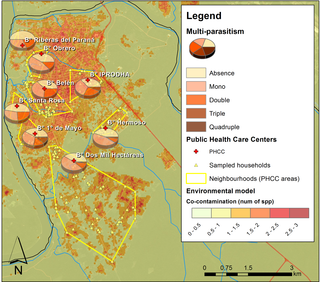PLOS Neglected Tropical Diseases ( IF 3.4 ) Pub Date : 2017-11-20 , DOI: 10.1371/journal.pntd.0006098 Maria Romina Rivero 1, 2 , Carlos De Angelo 2, 3, 4 , Pablo Nuñez 1, 2 , Martín Salas 1 , Carlos E Motta 5 , Alicia Chiaretta 5 , Oscar D Salomón 1, 2 , Song Liang 6, 7

|
Background
Intestinal parasitoses are a major concern for public health, especially in children from middle and low-income populations of tropical and subtropical areas. We examined the presence and co-infection of parasites in humans as well as parasitic environmental contamination in Puerto Iguazú, Argentina. We explored the environmental and socio-demographic characteristics of the persistence of parasites in children and their environment.
Methodology/Principal findings
This cross-section survey was conducted among children population comprised into the area of the public health care centers of Iguazú during June 2013 to May 2016. Copro-parasitological status of 483 asymptomatic children was assessed. Simultaneously, a design-based sampling of 744 soil samples and 530 dog feces was used for characterize the environmental contamination. The 71.5% of these sites were contaminated. Sixteen genera were detected in the environment being hookworms (62.0%) the main pathogens group detected followed by Toxocara spp (16.3%), Trichuris spp (15.2%) and Giardia (6.5%). Total children prevalence raised 58.8%, detecting twelve genera of parasite with Giardia intestinalis as the most prevalent pathogen (29.0%) followed by Enterobius vermicularis (23.0%), Hymenolepis nana (12.4%) and hookworms (4.4%). Through questionnaires and census data, we characterized the socio-demographics conditions at an individual, family and neighborhood levels. A multi-level analysis including environmental contamination data showed that the ´presence of parasites´ was mostly determined by individual (e.g. age, playing habits, previous treatment) and household level (e.g. UBN, WASH, mother's literacy) determinants. Remarkably, to define the level of ‘parasite co-infection’, besides individual and household characteristics, environmental factors at a neighborhood level were important.
Conclusion/Significance
Our work represents the major survey of intestinal parasites in human and environmental samples developed in the region. High prevalence was detected in the children population as well as in their environment. This work shows the importance of considering and promoting multi-level actions over the identified determinants to face this public health problem from integrative approaches.
中文翻译:

与阿根廷亚热带北部边境伊瓜苏儿童肠道寄生虫相关的环境和社会人口个人、家庭和邻里因素
背景
肠道寄生虫病是公共卫生的一个主要问题,尤其是热带和亚热带地区中低收入人群的儿童。我们检查了阿根廷伊瓜苏港人类寄生虫的存在和共同感染以及寄生虫环境污染。我们探讨了儿童及其环境中寄生虫持续存在的环境和社会人口特征。
方法/主要发现
这项横断面调查是在 2013 年 6 月至 2016 年 5 月期间对伊瓜苏公共卫生保健中心地区的儿童人口中进行的。对 483 名无症状儿童的粪便寄生虫状况进行了评估。同时,对 744 个土壤样本和 530 个狗粪便进行了基于设计的采样,用于表征环境污染。其中71.5%的场地受到污染。环境中检出16个属,其中钩虫属(62.0%)是检出的主要病原菌群,其次是弓蛔虫属(16.3%)、鞭虫属(15.2%)和贾第虫属(6.5%)。儿童总患病率上升了 58.8%,检测到 12 属寄生虫,其中肠贾第鞭毛虫是最常见的病原体(29.0%),其次是蛲虫(23.0%)、膜壳虫(12.4%)和钩虫(4.4%)。通过问卷调查和人口普查数据,我们描述了个人、家庭和社区层面的社会人口状况。包括环境污染数据在内的多层次分析表明,“寄生虫的存在”主要取决于个人(例如年龄、玩耍习惯、之前的治疗)和家庭水平(例如UBN、WASH、母亲的读写能力)决定因素。值得注意的是,为了定义“寄生虫双重感染”的水平,除了个人和家庭特征之外,社区层面的环境因素也很重要。
结论/意义
我们的工作代表了对该地区人类和环境样本中肠道寄生虫的主要调查。在儿童群体及其环境中发现了高患病率。这项工作表明,考虑和促进针对已确定的决定因素采取多层次行动,以综合方法应对这一公共卫生问题的重要性。











































 京公网安备 11010802027423号
京公网安备 11010802027423号